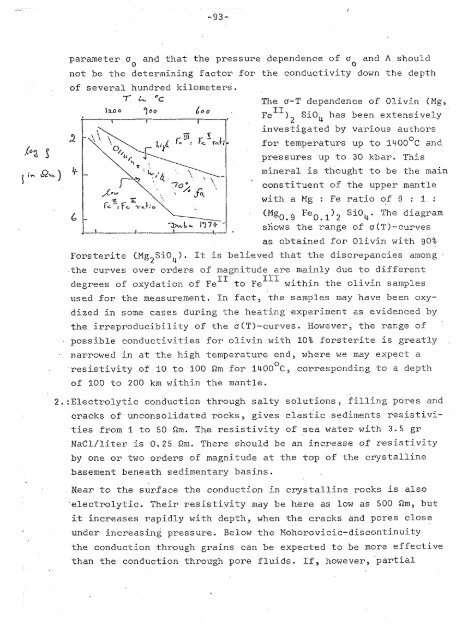Schmucker-Weidelt Lecture Notes, Aarhus, 1975 - MTNet
Schmucker-Weidelt Lecture Notes, Aarhus, 1975 - MTNet
Schmucker-Weidelt Lecture Notes, Aarhus, 1975 - MTNet
Create successful ePaper yourself
Turn your PDF publications into a flip-book with our unique Google optimized e-Paper software.
parameter u and that the pressure dependence of o and A should<br />
0 0<br />
not be the determining factor for the conductivity down the depth<br />
of several hundred kilometers.<br />
7 (, "C The u-T dependence of Olivin (Mg,<br />
1200 3 b0 60 0 11<br />
Fe ) Si04 has been extensively<br />
T--- 2<br />
investigated by various authors<br />
for temperaturs up to 1400~~ and<br />
pressures up to 30 kbar. This<br />
mineral is thought to be the main<br />
constituent of the upper mantle<br />
with a Mg : Fe ratio of 9 : 1 :<br />
I Si04. The diagram<br />
(Mg0.9 Fe~.l 2<br />
shows the range of u(T)--curves<br />
as obtained for Olivin with 90%<br />
Forsterite CMg2Si041. It is beli.eved that the discrepancies among<br />
-the curves over orders of magni:tude are mainly due to different<br />
degrees of oxydati-on of ~e" to Fe 'I within the olivLn samples<br />
used for the measurement. In fact, the samples may have been oxy-<br />
dized in some cases during the heating experiment as evidenced by<br />
the irreproducibility of the u (TI-curves. However, the r>ar.ge of<br />
possible conductivities for olivin with 10% forsterite is greatly<br />
narrowed in at the high temperature end, where we may expec-t a<br />
resistivity of 10 to 100 Qm for 1400°c, corresponding to a depth<br />
of 100 to 200 km within the mantle.<br />
2.:Electrolytic conduction through salty solutions, filling pores and<br />
cracks of unconsolidated rocks, gives clastic sediments resistivi-<br />
ties from 1 t o 50 Qm. The resistivity of sea water with 3.5 gr<br />
NaCl/liter is 0.25 am. There should be an increase of resistivity<br />
by one or two orders of magnitude at the top of the crystalline<br />
basement beneath sedimentary basins.<br />
Near to the surface the conduction in crystalline rocks is also<br />
electrolytic. Their resistivity may be here as low as 500 Qm, but<br />
it increases rapidly with depth, when the cracks and pores close<br />
under increasing pressure. Below the Mohorovicic-discontinuity<br />
the conduction through grains can be expected to be more effective<br />
than the conduction through pore fluids. If, however, partial
















